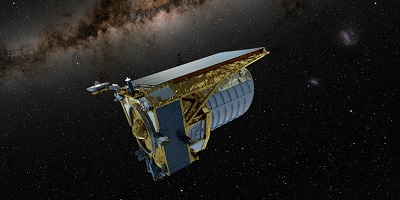San Francisco, (Asian independent) The European Space Agency’s (ESA) Euclid mission is on its way to explore the Universe’s mystery of dark matter and dark energy.
ESA’s Euclid spacecraft lifted off on a SpaceX Falcon 9 rocket from Cape Canaveral Space Force Station in Florida, US, at 17:12 CEST (8:42 pm IST) on July 1, 2023.
“The successful launch of Euclid marks the beginning of a new scientific endeavour to help us answer one of the most compelling questions of modern science,” said ESA Director General Josef Aschbacher, in a statement.
“If we want to understand the Universe we live in, we need to uncover the nature of dark matter and dark energy and understand the role they played in shaping our cosmos. To address these fundamental questions, Euclid will deliver the most detailed map of the extra-galactic sky,” added Carole Mundell, ESA’s Director of Science.
Over the next six years, Euclid will survey one third of the sky with unprecedented accuracy and sensitivity. It will observe billions of galaxies out to 10 billion light-years to create the largest, most accurate 3D map of the Universe, with the third dimension representing time itself.
This detailed chart of the shape, position and movement of galaxies will reveal how matter is distributed across immense distances and how the expansion of the Universe has evolved over cosmic history, enabling astronomers to infer the properties of dark energy and dark matter.
This will help scientists to improve understanding of the role of gravity and pin down the nature of these enigmatic entities.
To achieve its ambitious scientific goal, Euclid is equipped with a 1.2 m reflecting telescope that feeds the two innovative scientific instruments: the visible-wavelength camera (VIS), which takes very sharp images of galaxies over a large fraction of the sky, and Near-Infrared Spectrometer and Photometer (NISP), which can analyse galaxies’ infrared light by wavelength to accurately establish their distance.
US space agency NASA provided the detectors for NISP.
“By studying the ‘dark side’ of our universe, Euclid is not only paving the way for NASA’s Roman Space Telescope, it is igniting a new golden age of survey astronomy that will help us understand our universe’s history and structure in ways that were not possible before,” said Nicola Fox, associate administrator for NASA’s Science Mission Directorate in Washington, in a statement.
Scheduled to launch by May 2027, Roman will study a smaller section of sky than Euclid, but it will provide higher resolution images of millions of galaxies.
Euclid’s vast amount of data will be analysed by the Euclid Consortium — a group of more than 2000 scientists from more than 300 institutes across Europe, the US, Canada and Japan.
In the next four weeks, Euclid will travel towards Sun-Earth Lagrange point 2, an equilibrium point of the Sun-Earth system located 1.5 million km from Earth (about four times the Earth-Moon distance) in the direction opposite from the Sun.
There, Euclid will be manoeuvred into orbit around this point and mission controllers will start the activities to verify all the functions of the spacecraft, check out the telescope and finally turn on the scientific instruments.








